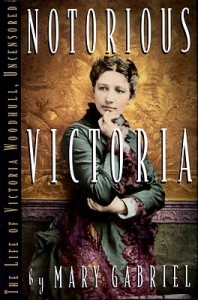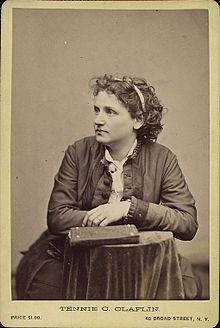 I heard the name of Victoria Woodhull in a specialized course, History of American Women, in college. My college years are considered pre-historic, and as such, you would have thought by now everyone would be not only aware of women who were movers and shakers in our past, but they’d be required study–or–like white males, just plain studied. No, of course not. 40 years more or less didn’t bring both sexes and various ethnic people into the discourse. History still belongs to those who write it and apparently those who write it are white males–or, and I have nothing to back this up except ignorance displayed by the younger among us, current history books and courses aren’t current in the sense of inclusion, but in edition number. When I was in grade and high school, the only women that had anything to do with our country’s beginnings consisted of one who mythically sewed a flag, and another who served water on the battlefield–oh, and one president’s wife saved some portraits when the White House burned. Betsy Ross’s house is nearby in Philly, and although the story is discredited time and again, the fantasy lives on. Molly Pitcher is immortalized in a touching way–one of the New Jersey Turnpike’s rest stops bears her name. And Dolly Madison churns out ice cream. That’s it, they are the sum total of women who existed with a contribution to our country’s emergence. And if you notice–their notoriety is contained within the domestic arena.
I heard the name of Victoria Woodhull in a specialized course, History of American Women, in college. My college years are considered pre-historic, and as such, you would have thought by now everyone would be not only aware of women who were movers and shakers in our past, but they’d be required study–or–like white males, just plain studied. No, of course not. 40 years more or less didn’t bring both sexes and various ethnic people into the discourse. History still belongs to those who write it and apparently those who write it are white males–or, and I have nothing to back this up except ignorance displayed by the younger among us, current history books and courses aren’t current in the sense of inclusion, but in edition number. When I was in grade and high school, the only women that had anything to do with our country’s beginnings consisted of one who mythically sewed a flag, and another who served water on the battlefield–oh, and one president’s wife saved some portraits when the White House burned. Betsy Ross’s house is nearby in Philly, and although the story is discredited time and again, the fantasy lives on. Molly Pitcher is immortalized in a touching way–one of the New Jersey Turnpike’s rest stops bears her name. And Dolly Madison churns out ice cream. That’s it, they are the sum total of women who existed with a contribution to our country’s emergence. And if you notice–their notoriety is contained within the domestic arena.
Perhaps Susan B. Anthony and her cohort in women’s rights were mentioned somewhere in the upper grade classes because we were at least aware of their existence and that women do indeed vote, now. I was enamored with the Roaring Twenties, as they were cutely called, and the Great Depression. so personally uncovered many other interesting women characters who were on the scene, for good or bad. Carrie Nation and her axe wiped out many a bar stool, Amee Semple MacPherson began an evangelistic movement that would have been the envy of Pat Robertson, and, low and behold, a first lady finally had something to do besides smile and nod. Eleanor Roosevelt’s work instigated social and racial change. Still, the couple hundred years the US has been around seems as though men reproduced among themselves for all the impact women appeared to have contributed.
and that women do indeed vote, now. I was enamored with the Roaring Twenties, as they were cutely called, and the Great Depression. so personally uncovered many other interesting women characters who were on the scene, for good or bad. Carrie Nation and her axe wiped out many a bar stool, Amee Semple MacPherson began an evangelistic movement that would have been the envy of Pat Robertson, and, low and behold, a first lady finally had something to do besides smile and nod. Eleanor Roosevelt’s work instigated social and racial change. Still, the couple hundred years the US has been around seems as though men reproduced among themselves for all the impact women appeared to have contributed.
Hopefully I’m wrong, out of touch with today’s education, and women, minorities and Native Americans are matter of factly part of the curriculum. I have my doubts. If this were the case, I believe that Victoria Woodhull would be included in the discussion of the women’s movement, as a pioneer in many important ways. The omission of her biography could only be deliberate, based not on dry history, but on moral indignation regarding her personal traits and actions.
On our road trip this last summer, a must stop for me was in a little Ohio town called Granville. Why? The historical society has a clock where upon each hour, a miniature Victoria Woodhull makes a grand entrance from behind little doors outside for the world to view the first woman to run for the presidency. I’d love to tell you the statue looked magnificent, the experience inspiring. Sadly, we waited and waited until it was clear she wasn’t going to appear. A mother with her two daughters had stopped to look, a habit when in town, while visiting the next door library. A storm had occurred a week before but although the weathervane was twisted, we were assured by the neighboring art store owner that the historical society had taken care of Victoria and she would saunter out on schedule. Victoria had become stuck outside and the only action taken was to force her back behind the doors. For all I know, she’s there still, not able to see the light of day. (How symbolic) Although very disappointed we wouldn’t get a glimpse of Ms. Woodhull, my greatest disappointment came from the children’s mother, when I heard her call the unseen statue, Queen Victoria. She hadn’t a clue who the clock housed. She was misinforming her girls, perpetuating Victoria Woodhull’s invisibility, and they were townspeople! They saw the clock constantly, and never bothered or was informed of whom the monument was created. When I explained and corrected the mother was amazed at this fascinating info. My hope is she takes her girls into the library next time and finds the book I am reading, and absorbs facts regarding the subject of the familiar clock and in doing so, two more girls who will eventually turn into women, will then pass on the info to other girls who will turn into women. If this is the only way American girls will ever hear about important historical female figures, it’s a very very sad commentary on this country’s inability to embrace all of it’s components who lived and died striving to benefit their fellow Americans.

Victoria Woodhull was born poor among a brood with a shifty, con artist and crook father, and passive mother. She was enamored of Spiritualism from an early age, and would get in touch with her spirit guides to make much needed money for her family, and then husband–whom she was charmed into marrying a couple of months after turning 15. Woodhull revealed himself to be an alcoholic nitwit and after bearing a mentally disabled son, her goal was to gain women their independence. She wanted women afforded the same rights as men– the right to divorce, inherit and keep money, vote, and generally

be considered a human being. She was lovely in looks, but not nearly as gorgeous as her sister, Tennessee, was considered. The two of them beguiled men where ever the entire clan traveled, supporting the family via spirit readings. But their starburst of fame came from opening up the first female brokerage on Wall Street. Hundreds would pay them a visit, not necessarily to invest, but to ogle these novelty ladies and see them in their native habitat, which was plush and luxurious. They didn’t gain this brokerage alone–Cornelius Vanderbilt took a shinning to Tennessee and bestowed some funds upon the sisters. After making a considerable amount of money, Victoria and her new beau began what was the first newspaper run by a woman. It was radical and the first to print in English Karl Marx’s manifesto.
So what was her downfall, because you know she must have been taken down, otherwise she would be proclaimed from school towers. She had the audacity to print the unsubstantiated claim, which was actually pretty well known, of a adulterous affair between a pinnacle of society, the Rev. Beecher and another man’s wife in her newspaper in response to his attacks on her concept of ‘free love’. Free Love wasn’t as literal as supposed–it was meant more in the spirit of women have the rights to their own bodies and should be accorded access to divorce as easily and without scandal as men were, to be freed from drunkards, wife beaters, etc., which in society at that time, was unheard of. A woman took her lumps and liked it, as the cartoonist who brought us jolly old
St. Nick explained via one of his political cartoons. Days before the presidential election she was running in was held, she, her sister, and her new husband were arrested and jailed on obscenity charges for printing the story. Beecher was sued by his lover’s husband, and the trial was followed like the OJ debacle. A hung jury resulted. Eventually Victoria traveled to England for what can only be assumes was a new start. After lecturing a bit, she married again, and after her husband’s death, retired to the countryside, and was heard of no more, although she lived until the age of 88. At least she was alive to see woman not only vote, but divorce with ease, own their own property, cut their hair, (as she once did), wear trousers, smoke, drink and otherwise act like men, if still not afforded all the rights men have.
Victoria Woodhull wasn’t only ahead of her time, she was too large, too over the top for both sexes. A woman will only be taken seriously then

and now, if quiet, unassuming, and still bakes cookies. Ask Hilary Clinton, she was manhandled for attempting to bring about health care change. It was only when she became less strident in tone, and more wifely, people allowed her to resume displaying her superior intellect openly. Since her, our first ladies have sedately taken on traditional womanly roles of advocating reading, and growing vegetables. And if a present day Victoria were to soar across the horizon, she’d be treated exactly the same as the historical one. Women have yet to become completely visible.
The bio I’ve been reading is: Notorious Victoria by Mary Gabriel
For a website devoted to Victoria Woodhull

The evolution of the publishing industry make a book like this possible today. I confess I never heard of Victoria Woodhull until I read your blog post. As a history buff I can really see myself enjoying this book.